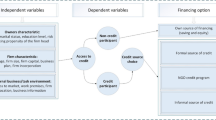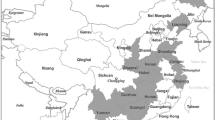Abstract
Women’s empowerment is important indicator for social development, yet there has not been a practical index on women’s empowerment at household level, especially for developing countries. Previous studies have suggested a theoretical framework of four components of women’s empowerment at household level: women’s labor force participation, women’s household decision-making, women’s use of contraception and women’s education. In this study, a measurement of women’s empowerment is developed using principal axis factoring with micro data from the Demographic and Health Surveys on four Southeast Asia countries including Cambodia, Indonesia, Philippines and Timor-Leste. The results has consistently found three factors including women’s labor force participation, women’s education and women’s household decision-making that affect individual women’s empowerment. Nevertheless, despite the literature suggested by other studies, very little evidence was found to support family planning use as one of the components of women’s empowerment in these countries. The new measurement also provides a solution for the problem of lacking household level data in current indices. More importantly, the construction of the measurement is practically applicable in more than 90 developing countries where the Demographic and Health Surveys are available.





Similar content being viewed by others
References
Afifi, M. (2007). Lactational amenorrhoea method for family planning and women empowerment in Egypt. Singapore Medical Journal, 48(8), 758–762.
Alkire, S., Meinzen-Dick, R., Peterman, A., Quisumbing, A., Seymour, G., & Vaz, A. (2013). The women’s empowerment in agriculture index. World Development, 52, 71–91.
Axinn, W. G., & Barber, J. S. (2001). Mass education and fertility limitation. American Sociological Review, 66, 481–505.
Batliwala, S. (1994). The meaning of empowerment: New concepts from action. In G. Sen, A. Germain, & L. C. Chen (Eds.), Population policies reconsidered: Health, empowerment and rights (pp. 127–138). Cambridge: Harvard University Press.
Beteta, H. C. (2006). What is missing in measures of women’s empowerment? Journal of Human Development, 7(2), 221–241.
Bradley, C. (1995). Women’s empowerment and fertility decline in Western Kenya. In S. Greenhalgh (Ed.), Situating fertility. Anthropology and demographic inquiry (pp. 157–178). Cambridge: Cambridge University Press.
Brewster, K. L., & Rindfuss, R. R. (2000). fertility and women’s employment in industrialized nations. Annual Review of Sociology, 26, 271–296.
Charmes, J., & Wieringa, S. (2003). Measuring women’s empowerment: An assessment of the gender related development index and gender empowerment index. Journal of Human Development, 4(3), 419–435.
Coleman, I. (2004). Payoff from women’s rights. Foreign Affairs, 83, 80.
Constello, A. B., & Osborne, J. W. (2005). Best practicies in exploratory factor analysis: Four recommendations for getting the most from your analysis. Practical Assessment, Research & Evaluation, 10(7), 1–9.
Desai, M. (2010). Hope in hard times: Women’s empowerment and human development. Human Development Research Paper 14.
Grown, C., Gupta, G. R., & Pande, R. (2005). Taking action to improve women’s health through gender equality and women’s empowerment. The Lancet, 365(9458), 541–543.
Gupta, M. D. (1996). Life course perspectives on women’s autonomy and health outcomes. Health Transition Review, 6, 213–231.
Isamail, M., Rasdi, R. M., & Nadriah, A. (2011). Gender empowerment measure in political achievement in selected developed and developing countries. Gender in Management: An International Journal, 26(5), 380–392.
Kabeer, N. (2005). Gender equality and women’s empowerment: A critical analysis of the third millennium development goal. Gender & Development, 13(1), 13–24.
Kawachi, I., Kennedy, B. P., Gupta, V., & Prothrow-Stith, D. (1999). Women’s status and the health of women and men: A view from the states. Social Science and Medicine, 48(1), 21–32.
Larsen, U., & Hollos, M. (2003). Women’s empowerment and fertility decline among the pare of Kilimanjaro region, Northern Tanzania. Social Sciences & Medicine, 57, 1099–1115.
Lee-Rife, S. M. (2010). Women’s empowerment and reproductive experiences over the lifecourse. Social Sciences and Medicine, 71, 634–642.
Lopez-Claros, A., & Zahidi, S. (2005). Women’s empowerment: Measuring the global gender gap. Cologny Geneva: World Economic Forum.
Malhotra, A., & Schuler, S. R. (2005). Women’s empowerment as a variable in international development. Measuring empowerment: Cross-disciplinary perspectives (pp. 71–88). Washington D.C: World Bank publications.
Malhotra, A., Schulerm, S., & Boender, C. (2002). Measuring women’s empowerment as a variable in international development. Paper presented at the The World Bank Workshop on Poverty and Gender: New Perspectives.
Mason, K. O. (1987). The impact of women’s social position on fertility in developing countries. Sociological Forum, 2(4), 718–745.
Mason, K. O., & Smith, H. L. (2000). Husbands’ versus wives fertility foals and use of contraception: The influence of gender context in five asian countries. Demography, 37(3), 299–311.
Mosedale, S. (2005). Assessing women’s empowerment: Towards a conceptual framework. Journal of International Development, 17(2), 243–257.
Odutolu, O., Adedimeji, A., Odutolu, O., Baruwa, O., & Olatidoye, F. (2003). Economic empowerment and reproductive behavior of young women in Osun state, Nigeria. African Journal of Reproductive Health, 7(3), 92–100.
Sen, G. (1993). Women’s empowerment and human rights: The challenge to policy. Paper presented at the Population Summit of the World’s Scientific Academies.
Shoaib, M., Saeed, Y., & Cheema, S. N. (2012). Education and women’s empowerment at household level: A case study of women in rural Chiniot, Pakistan. Academic Research International, 2(1), 519–526.
Tengland, P.-A. (2008). Empowerment: A conceptual discussion. Health Care Analysis, 16, 77–96.
Thang, N. M., & Anh, D. N. (2002). Accessibility and use of contraceptives in vietnam. International Family Planning Perspectives, 28(4), 214–219.
Upadhyay, U. D., & Karasek, D. (2012). Women’s Empowerment and ideal family size: An examination of DHS empowerment measures in Sub-Saharan Africa. International Perspectives on Sexual and Reproductive Health, 38(2), 78–89.
Author information
Authors and Affiliations
Corresponding author
Rights and permissions
About this article
Cite this article
Phan, L. Measuring Women’s Empowerment at Household Level Using DHS Data of Four Southeast Asian Countries. Soc Indic Res 126, 359–378 (2016). https://doi.org/10.1007/s11205-015-0876-y
Accepted:
Published:
Issue Date:
DOI: https://doi.org/10.1007/s11205-015-0876-y




